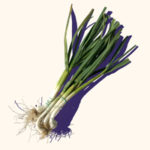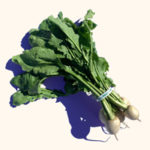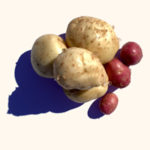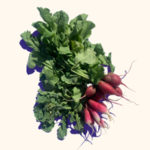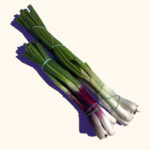What’s in my box this week?
Click on your delivery date to see what is in your box this week. Note that the web site is updated daily to reflect the NEXT day’s deliveries but before that, will show the information from the previous week. You can check an earlier day in the week to get an idea of what will be in your box, but the contents of your box may be different as the box contents frequently change between days.
Tuesday: April 23
- carrots
- green garlic
- hakurei turnips
- lettuce
- mandarin oranges
- potatoes
- red mustard
*Click on produce above for Recipes
Flower of the Week: a snapdragon and Bells of Ireland duet
Veggie Tips
Carrots – These are the same carrots you know and love, just without the greens. They make an excellent snack or see our website for many tasty recipe ideas.
Green Garlic – In fall we plant cloves (a combination of purchased seed garlic and our own saved garlic) and green garlic is just the immature form of garlic. Between now and June, they’ll form cloves and will bulb out at the bottom, but for now, they look more like little leeks, and much like leeks, you can use the whole stalk. Green garlic should be kept in the refrigerator in a bag. You can add green garlic to any dish you would make with cured garlic (one stalk is about equal to one large clove) or you can make something with more delicate flavors to highlight the taste of green garlic. Green garlic is excellent added to eggs, sautéed greens, or any potato dish: roasted, mashed (with Indian spices), gratin, or soup. Green garlic can also be made into a pesto. More about green garlic here.
Hakurei Turnips – These farm favorites go by several names: salad turnips, Tokyo turnips, and Japanese turnips. They’re called salad turnips because they have a sweet flavor and taste good raw (like in this slaw). They are much more tender and sweeter than purple top turnips and don’t need to be peeled or cooked as long. If you are cooking your turnips, consider a stir-fry. They can also be roasted, sautéed, braised, boiled, grilled, steamed, mashed, and are tasty pickled. The greens are tender and soft, with a mild taste – you’re missing out if you don’t eat them. You can cook the greens with the turnips (sautéed, pan-roasted, stir-fried, in a grain salad, or oven-roasted, including with mushrooms or mustard) or use them raw anywhere you’d use arugula or other tender greens, like turnip greens gome. You can also combine your turnips (and/or the greens) with your mustard greens: raw or sautéed. Or make a pesto, which tastes excellent with roasted roots). Other ideas: pasta with turnip pesto, roasted with za’atar, miso soba soup, with rice, a salad with yogurt and spring herbs, or any of the ideas on this list or on our website (the miso turnip recipe is very popular). To store: remove the greens and store the greens and roots in separate plastic bags in the fridge. The leaves have a short shelf-life, so use fairly quickly.
Lettuce or Salad Mix – Store in the refrigerator – if not eating within a day or two, transfer to a plastic bag, or put the waxed paper bag in plastic, to avoid wilting. If your lettuce does get a little wilted, follow this tip for reviving it! More recipe ideas on our website on the lettuce or salad pages.
Mandarin Oranges – These are Murcott mandarins from our friends and neighbors at Gold Oak Ranch. They may be stored in a cool, dark spot for a few days, or even on your counter but ideally should be refrigerated to extend shelf life up to two weeks. Some of them may look a little dirty – that’s not dirt, but a side effect of scale, which is a common citrus pest. It doesn’t impact the quality of the fruit. We’ve put the mandarins through our fruit washer, but they’re not spotless.
Potatoes – We’re currently harvesting Bintje (white) and Bella Roja (red). Store in the refrigerator and out of the light (we recommend a paper bag). See the many recipe ideas on our website.
Red Mustard Greens – Whenever we put the karinata kale in your boxes, we say that it’s a mix of red mustard and kale. Well – this is red mustard, and you’ll notice the similar flavor, a little peppery with slight notes of garlic. Some people compare it to horseradish. These greens have a slight spicy bite, similar to arugula, and a softer texture than kale, also closer to arugula. Make sure to store in the refrigerator in some sort of bag that will prevent them from drying out and wilting. Mustard greens can be enjoyed raw or cook them. For raw: you can make a salad, including mixing with lettuce (maybe add carrots, or consider a green garlic dressing). For cooking: you can’t go wrong with sautéing, stir-frying, or braising, and the sky’s the limit to other ingredients and flavors that you can add (like roasted potatoes, mushrooms, or carrots). Mustards are commonly used in Indian cooking, like the Recipe of the Week or or this dish with potatoes. They are great with eggs (scrambled or a fritatta), or with pasta and noodles, especially soba noodles. Mustard greens also can be pickled (with or without garlic), made into sauces like pesto, harissa, gremolata, or this sauce. You can use mustard greens in any of the hearty green or tender green recipes on our website, you just may want to cook the greens more or less, and you can get additional basic cooking tips here. But for some mustard-specific ideas, you can also find some ideas here, here, and here.
Wednesday: April 24
- carrots
- green garlic
- lettuce
- mandarin oranges
- potatoes
- radishes
- red mustard
*Click on produce above for Recipes
Flower of the Week: a snapdragon and Bells of Ireland duet
Veggie Tips
Carrots – These are the same carrots you know and love, just without the greens. They make an excellent snack or see the Recipe of the Week or our website for many tasty recipe ideas.
Green Garlic – In fall we plant cloves (a combination of purchased seed garlic and our own saved garlic) and green garlic is just the immature form of garlic. Between now and June, they’ll form cloves and will bulb out at the bottom, but for now, they look more like little leeks, and much like leeks, you can use the whole stalk. Green garlic should be kept in the refrigerator in a bag. You can add green garlic to any dish you would make with cured garlic (one stalk is about equal to one large clove) or you can make something with more delicate flavors to highlight the taste of green garlic. Green garlic is excellent added to eggs, sautéed greens, or any potato dish: roasted, mashed (with Indian spices), gratin, or soup. Green garlic can also be made into a pesto. More about green garlic here.
Lettuce or Salad Mix – Store in the refrigerator – if not eating within a day or two, transfer to a plastic bag, or put the waxed paper bag in plastic, to avoid wilting. If your lettuce does get a little wilted, follow this tip for reviving it! More recipe ideas on our website on the lettuce or salad pages.
Mandarin Oranges – These are Murcott mandarins from our friends and neighbors at Gold Oak Ranch. They may be stored in a cool, dark spot for a few days, or even on your counter but ideally should be refrigerated to extend shelf life up to two weeks. Some of them may look a little dirty – that’s not dirt, but a side effect of scale, which is a common citrus pest. It doesn’t impact the quality of the fruit. We’ve put the mandarins through our fruit washer, but they’re not spotless. If you (somehow!) are looking for something else to do with your mandarins aside from eating them plain, you can make a sauce for roasted carrots.
Potatoes – We’re currently harvesting Bintje (white) and Bella Roja (red). Store in the refrigerator and out of the light (we recommend a paper bag). See the Recipe of the Week, or the many recipe ideas on our website.
Radishes – French breakfast radishes in your box! Crisp and spicy, with the added bonus of the greens on top. They make an excellent addition to a salad, tacos, omelets, toast (or French toast), and they are great pickled. If you don’t like the spiciness of radishes, definitely cook them; they lose their heat when sautéed, braised, or roasted. Don’t toss the greens! You can sauté them, make a sauce (like pesto or chimichurri) or add them to salads or slaws (bok choi slaw too!), sandwiches (in place of lettuce or arugula). Eat the roots and leaves together in pasta, soup, polenta, stir-fry, or salad. More ideas here. For best storage, separate the roots from the greens and keep both in a bag in the refrigerator. The leaves have a short shelf-life, so use quickly. More recipe ideas here, or on our website.
Red Mustard Greens or Purple Bok Choi – You’ll either get a bunch of purple bok choi or red mustard. Both are members of the mustard family and can be used interchangeably. However, the bok choi is a bit crisper and much less spicy than mustard greens. If you don’t know which one you have, try a leaf (it should quickly become obvious!), do a quick online search, or send us a picture and we can ID it for you. Included below are notes on both crops!
- Mustards: Whenever we put the karinata kale in your boxes, we say that it’s a mix of red mustard and kale. Well – this is red mustard, and you’ll notice the similar flavor, a little peppery with slight notes of garlic. Some people compare it to horseradish. These greens have a slight spicy bite, similar to arugula, and a softer texture than kale, also closer to arugula. Make sure to store in the refrigerator in some sort of bag that will prevent them from drying out and wilting. Mustard greens can be enjoyed raw or cook them. For raw: you can make a salad, including mixing with lettuce (maybe add carrots, or consider a green garlic dressing). For cooking: you can’t go wrong with sautéing, stir-frying, or braising, and the sky’s the limit to other ingredients and flavors that you can add (like roasted potatoes, mushrooms, or carrots). Mustards are commonly used in Indian cooking like this recipe for darson da saag, like or this dish with potatoes. They are great with eggs (scrambled or a fritatta), or with pasta and noodles, especially soba noodles. Mustard greens also can be pickled (with or without garlic), made into sauces like pesto, harissa, gremolata, or this sauce. You can use mustard greens in any of the hearty green or tender green recipes on our website, you just may want to cook the greens more or less, and you can get additional basic cooking tips here. But for some mustard-specific ideas, you can also find some ideas here, here, and here.
- Bok choi: Bok choi makes a great stir-fry and is also excellent in soup, stew, noodles, curry, a warm salad, or enjoy it raw in a salad (some ideas on our website or try this one). Less conventional ideas: lasagna, tacos, or risotto. You can also grill or roast bok choi (you can also roast with gnocchi or make choi chips!). You can find a rundown of six different cooking methods here. Additional bok choi ideas on our website, or here or here.
Thursday: April 25
- bok choi
- carrots
- green garlic
- hakurei turnips
- lettuce
- mandarin oranges
- potatoes
*Click on produce above for Recipes
Flower of the Week: a snapdragon and Bells of Ireland duet
Veggie Tips
Bok Choi – We grow three types – the large white-stemmed (joi choi), the shorter green-stemmed (mei qing, or Shanghai), and purple. All have different shapes but are equally delicious with crunchy stems and soft leaves. Bok choi makes a great stir-fry (especially with your turnips and/or the turnip greens) and it is also excellent in soup, stew, noodles, curry, ramen (with turnips), a warm salad, or enjoy it raw in a salad (some ideas on our website or try this one). Less conventional ideas: lasagna, tacos, or risotto. You can also grill or roast bok choi (you can also roast with gnocchi or make choi chips!). You can find a rundown of six different cooking methods here. Additional bok choi ideas on our website, or here or here. Store in the refrigerator in a bag. Some of the plants have started to flower; bok choi rabe is delicious so make sure you eat it too!
Carrots – These are the same carrots you know and love, just without the greens. They make an excellent snack or see the Recipe of the Week or our website for many tasty recipe ideas.
Green Garlic – In fall we plant cloves (a combination of purchased seed garlic and our own saved garlic) and green garlic is just the immature form of garlic. Between now and June, they’ll form cloves and will bulb out at the bottom, but for now, they look more like little leeks, and much like leeks, you can use the whole stalk. Green garlic should be kept in the refrigerator in a bag. You can add green garlic to any dish you would make with cured garlic (one stalk is about equal to one large clove) or you can make something with more delicate flavors to highlight the taste of green garlic. Green garlic is excellent added to eggs, sautéed greens, or any potato dish: roasted, mashed (with Indian spices), gratin, or soup. Green garlic can also be made into a pesto. More about green garlic here.
Hakurei Turnips – These farm favorites go by several names: salad turnips, Tokyo turnips, and Japanese turnips. They’re called salad turnips because they have a sweet flavor and taste good raw (like in this slaw). They are much more tender and sweeter than purple top turnips and don’t need to be peeled or cooked as long. If you are cooking your turnips, consider a stir-fry. They can also be roasted, sautéed, braised, boiled, grilled, steamed, mashed, and are tasty pickled. The greens are tender and soft, with a mild taste – you’re missing out if you don’t eat them. You can cook the greens with the turnips (sautéed, pan-roasted, stir-fried, in a grain salad, or oven-roasted, including with mushrooms or mustard) or use them raw anywhere you’d use arugula or other tender greens, like turnip greens gome. You can also combine your turnips (and/or the greens) with your mustard greens: raw or sautéed. Or make a pesto, which tastes excellent with roasted roots). Other ideas: pasta with turnip pesto, roasted with za’atar, miso soba soup, with rice, a salad with yogurt and spring herbs, or any of the ideas on this list or on our website (the miso turnip recipe is very popular). To store: remove the greens and store the greens and roots in separate plastic bags in the fridge. The leaves have a short shelf-life, so use fairly quickly.
Lettuce or Salad Mix – Store in the refrigerator – if not eating within a day or two, transfer to a plastic bag, or put the waxed paper bag in plastic, to avoid wilting. If your lettuce does get a little wilted, follow this tip for reviving it! More recipe ideas on our website on the lettuce or salad pages.
Mandarin Oranges – These are Murcott mandarins from our friends and neighbors at Gold Oak Ranch. They may be stored in a cool, dark spot for a few days, or even on your counter but ideally should be refrigerated to extend shelf life up to two weeks. Some of them may look a little dirty – that’s not dirt, but a side effect of scale, which is a common citrus pest. It doesn’t impact the quality of the fruit. We’ve put the mandarins through our fruit washer, but they’re not spotless.
Potatoes – We’re currently harvesting Bintje (white) and Bella Roja (red). Store in the refrigerator and out of the light (we recommend a paper bag). See the many recipe ideas on our website.
Friday: April 26
- bok choi
- carrots
- green garlic
- hakurei turnips
- lettuce
- mandarin oranges
- potatoes
*Click on produce above for Recipes
Flower of the Week: a snapdragon and Bells of Ireland duet
Veggie Tips
Bok Choi – We grow three types – the large white-stemmed (joi choi), the shorter green-stemmed (mei qing, or Shanghai), and purple. All have different shapes but are equally delicious with crunchy stems and soft leaves. Bok choi makes a great stir-fry (especially with your turnips and/or the turnip greens) and it is also excellent in soup, stew, noodles, curry, ramen (with turnips), a warm salad, or enjoy it raw in a salad (some ideas on our website or try this one). Less conventional ideas: lasagna, tacos, or risotto. You can also grill or roast bok choi (you can also roast with gnocchi or make choi chips!). You can find a rundown of six different cooking methods here. Additional bok choi ideas on our website, or here or here. Store in the refrigerator in a bag. Some of the plants have started to flower; bok choi rabe is delicious so make sure you eat it too!
Carrots – These are the same carrots you know and love, just without the greens. They make an excellent snack or see the Recipe of the Week or our website for many tasty recipe ideas.
Green Garlic – In fall we plant cloves (a combination of purchased seed garlic and our own saved garlic) and green garlic is just the immature form of garlic. Between now and June, they’ll form cloves and will bulb out at the bottom, but for now, they look more like little leeks, and much like leeks, you can use the whole stalk. Green garlic should be kept in the refrigerator in a bag. You can add green garlic to any dish you would make with cured garlic (one stalk is about equal to one large clove) or you can make something with more delicate flavors to highlight the taste of green garlic. Green garlic is excellent added to eggs, sautéed greens, or any potato dish: roasted, mashed (with Indian spices), gratin, or soup. Green garlic can also be made into a pesto. More about green garlic here.
Hakurei Turnips – These farm favorites go by several names: salad turnips, Tokyo turnips, and Japanese turnips. They’re called salad turnips because they have a sweet flavor and taste good raw (like in this slaw). They are much more tender and sweeter than purple top turnips and don’t need to be peeled or cooked as long. If you are cooking your turnips, consider a stir-fry. They can also be roasted, sautéed, braised, boiled, grilled, steamed, mashed, and are tasty pickled. The greens are tender and soft, with a mild taste – you’re missing out if you don’t eat them. You can cook the greens with the turnips (sautéed, pan-roasted, stir-fried, in a grain salad, or oven-roasted, including with mushrooms or mustard) or use them raw anywhere you’d use arugula or other tender greens, like turnip greens gome. You can also combine your turnips (and/or the greens) with your mustard greens: raw or sautéed. Or make a pesto, which tastes excellent with roasted roots). Other ideas: pasta with turnip pesto, roasted with za’atar, miso soba soup, with rice, a salad with yogurt and spring herbs, or any of the ideas on this list or on our website (the miso turnip recipe is very popular). To store: remove the greens and store the greens and roots in separate plastic bags in the fridge. The leaves have a short shelf-life, so use fairly quickly.
Lettuce or Salad Mix – Store in the refrigerator – if not eating within a day or two, transfer to a plastic bag, or put the waxed paper bag in plastic, to avoid wilting. If your lettuce does get a little wilted, follow this tip for reviving it! More recipe ideas on our website on the lettuce or salad pages.
Mandarin Oranges – These are Murcott mandarins from our friends and neighbors at Gold Oak Ranch. They may be stored in a cool, dark spot for a few days, or even on your counter but ideally should be refrigerated to extend shelf life up to two weeks. Some of them may look a little dirty – that’s not dirt, but a side effect of scale, which is a common citrus pest. It doesn’t impact the quality of the fruit. We’ve put the mandarins through our fruit washer, but they’re not spotless.
Potatoes – We’re currently harvesting Bintje (white) and Bella Roja (red). Store in the refrigerator and out of the light (we recommend a paper bag). See the many recipe ideas on our website.
Saturday: April 27
- bok choi
- carrots
- green garlic
- hakurei turnips
- lettuce
- mandarin oranges
- potatoes
*Click on produce above for Recipes
Flower of the Week: a snapdragon and Bells of Ireland duet
Veggie Tips
Bok Choi – We grow three types – the large white-stemmed (joi choi), the shorter green-stemmed (mei qing, or Shanghai), and purple. All have different shapes but are equally delicious with crunchy stems and soft leaves. Bok choi makes a great stir-fry (especially with your turnips and/or the turnip greens) and it is also excellent in soup, stew, noodles, curry, ramen (with turnips), a warm salad, or enjoy it raw in a salad (some ideas on our website or try this one). Less conventional ideas: lasagna, tacos, or risotto. You can also grill or roast bok choi (you can also roast with gnocchi or make choi chips!). You can find a rundown of six different cooking methods here. Additional bok choi ideas on our website, or here or here. Store in the refrigerator in a bag. Some of the plants have started to flower; bok choi rabe is delicious so make sure you eat it too!
Carrots – These are the same carrots you know and love, just without the greens. They make an excellent snack or see the Recipe of the Week or our website for many tasty recipe ideas.
Green Garlic – In fall we plant cloves (a combination of purchased seed garlic and our own saved garlic) and green garlic is just the immature form of garlic. Between now and June, they’ll form cloves and will bulb out at the bottom, but for now, they look more like little leeks, and much like leeks, you can use the whole stalk. Green garlic should be kept in the refrigerator in a bag. You can add green garlic to any dish you would make with cured garlic (one stalk is about equal to one large clove) or you can make something with more delicate flavors to highlight the taste of green garlic. Green garlic is excellent added to eggs, sautéed greens, or any potato dish: roasted, mashed (with Indian spices), gratin, or soup. Green garlic can also be made into a pesto. More about green garlic here.
Hakurei Turnips – These farm favorites go by several names: salad turnips, Tokyo turnips, and Japanese turnips. They’re called salad turnips because they have a sweet flavor and taste good raw (like in this slaw). They are much more tender and sweeter than purple top turnips and don’t need to be peeled or cooked as long. If you are cooking your turnips, consider a stir-fry. They can also be roasted, sautéed, braised, boiled, grilled, steamed, mashed, and are tasty pickled. The greens are tender and soft, with a mild taste – you’re missing out if you don’t eat them. You can cook the greens with the turnips (sautéed, pan-roasted, stir-fried, in a grain salad, or oven-roasted, including with mushrooms or mustard) or use them raw anywhere you’d use arugula or other tender greens, like turnip greens gome. You can also combine your turnips (and/or the greens) with your mustard greens: raw or sautéed. Or make a pesto, which tastes excellent with roasted roots). Other ideas: pasta with turnip pesto, roasted with za’atar, miso soba soup, with rice, a salad with yogurt and spring herbs, or any of the ideas on this list or on our website (the miso turnip recipe is very popular). To store: remove the greens and store the greens and roots in separate plastic bags in the fridge. The leaves have a short shelf-life, so use fairly quickly.
Lettuce or Salad Mix – Store in the refrigerator – if not eating within a day or two, transfer to a plastic bag, or put the waxed paper bag in plastic, to avoid wilting. If your lettuce does get a little wilted, follow this tip for reviving it! More recipe ideas on our website on the lettuce or salad pages.
Mandarin Oranges – These are Murcott mandarins from our friends and neighbors at Gold Oak Ranch. They may be stored in a cool, dark spot for a few days, or even on your counter but ideally should be refrigerated to extend shelf life up to two weeks. Some of them may look a little dirty – that’s not dirt, but a side effect of scale, which is a common citrus pest. It doesn’t impact the quality of the fruit. We’ve put the mandarins through our fruit washer, but they’re not spotless.
Potatoes – We’re currently harvesting Bintje (white) and Bella Roja (red). Store in the refrigerator and out of the light (we recommend a paper bag). See the many recipe ideas on our website.
Wednesday: April 17
- bok choi
- broccoli
- carrots
- hakurei turnips
- mandarin oranges
- parsley
- spring onions
*Click on produce above for Recipes
Flower of the Week: ranunculus
Veggie Tips
Bok Choi – We grow three types – the large white-stemmed (joi choi), the shorter green-stemmed (mei qing, or Shanghai), and purple. All have different shapes but are equally delicious with crunchy stems and soft leaves. Bok choi makes a great stir-fry, see the Recipe of the Week or you can add broccoli. It is also excellent in soup, stew, noodles, curry, a warm salad, or enjoy it raw in a salad (some ideas on our website or try this one). Less conventional ideas: lasagna, tacos, or risotto. You can also grill or roast bok choi (you can also roast with gnocchi or make choi chips!). You can find a rundown of six different cooking methods here. Additional bok choi ideas on our website, or here or here. Store in the refrigerator in a bag. Some of the plants have started to flower; bok choi rabe is delicious so make sure you eat it too!
Broccoli – Broccoli in your box can come in a few formats: heads, bunched spears, and loose spears. We get multiple harvests off of each plant. Broccoli first produces a large head and then after that is harvested, the plants send out smaller shoots. This week you’ll either be getting a bag of broccoli spears, or bunched broccoli. If you get a bunch, make sure to use the sweet crunchy stems – either add earlier to your dish, or enjoy them like carrots (raw, roasted, stir-fried). Broccoli is great roasted (four recipe ideas with roasted broccoli here), steamed (basic instructions here, and you can also make a pasta sauce), blanched, stir-fried, sauteed, added to soups (especially good with potato), broiled, grilled, or raw. Maybe try with spring onions: broiled, roasted, roasted with a Thai vinaigrette, mac and cheese, or noodles. Or with carrots (stir-fry or rice bowl) or parsley (a stew, broccoli tabbouleh, or grilled). Lots more broccoli recipes on our website or parsley (. Store broccoli in the refrigerator in a bag, with additional storage tips here.
Carrots – separate the roots from the greens before storing them in the refrigerator to help them stay crunchy and crisp. If they do get a little limp, you can revive them by putting them in water, even for just five minutes. Carrots make an excellent snack or check out the recipes on our website for other ideas. Definitely save one or two for the Recipe of the Week. A CSA member wrote to strongly endorse this soup and someone else wrote to recommend this soup recipe, which uses parsley! Give your carrot greens a try! They can be used in a broth, pesto (which you can enjoy with the roots) chimichurri, or soup.
Hakurei Turnips – These farm favorites go by several names: salad turnips, Tokyo turnips, and Japanese turnips. They’re called salad turnips because they have a sweet flavor and taste good raw (like in this slaw). They are much more tender and sweeter than purple top turnips and don’t need to be peeled or cooked as long. If you are cooking your turnips, consider a stir-fry. They can also be roasted, sautéed, braised, boiled, grilled, steamed, mashed, and are tasty pickled. The greens are tender and soft, with a mild taste – you’re missing out if you don’t eat them. You can cook the greens with the turnips (sautéed, pan-roasted, stir-fried, in a grain salad, or oven-roasted, including with mushrooms or mustard) or use them raw anywhere you’d use arugula or other tender greens, like turnip greens gome. Or make a pesto, which tastes excellent with roasted roots). Other ideas: pasta with turnip pesto, roasted with za’atar, miso soba soup, with rice, a salad with yogurt and spring herbs, or any of the ideas on this list or on our website (the miso turnip recipe is very popular). To store: remove the greens and store the greens and roots in separate plastic bags in the fridge. The leaves have a short shelf-life, so use fairly quickly.
Mandarin Oranges – These are Murcott mandarins from our friends and neighbors at Gold Oak Ranch. They may be stored in a cool, dark spot for a few days, or even on your counter but ideally should be refrigerated to extend shelf life up to two weeks. Some of them may look a little dirty – that’s not dirt, but a side effect of scale, which is a common pest on citrus. We’ve put the mandarins through our fruit washer, but they’re not spotless. It’s not harmful at all, and doesn’t impact the quality of the fruit which is incredibly sweet and juicy.
Parsley – It’s very easy to use up a whole bunch of parsley if you make sauce like chimmichurri (which can also include radish greens), gremolata, miso sauce, pesto, herb oil, or another parsley-heavy dish. Other ideas: pasta, carrot soup, or even a parsley salad. But if you’re using it more slowly and are looking to keep it fresh for a longer period, you should keep it in the refrigerator in a plastic bag, a plastic bag wrapped in a damp paper towel, or in a glass of water (like a bunch of flowers, or basil) covered loosely with a plastic bag. Check out the many recipe ideas on our website.
Spring Onions – Spring onions are immature onions; just like the green garlic, you’ll see them bulk up over time, and once they are full size, we will dry and cure them. For the moment, they look like scallions/green onions and are similar, albeit with a slightly stronger and sweeter flavor. Compared to cured onions, they have a brighter, fresher flavor, which makes them good for raw applications. They should be stored in the refrigerator, sealed well in a plastic bag (or your preferred non-plastic alternative), and they’ll stay fresh for about two weeks. Don’t throw out the tops! Use the tops just like you would scallions – perfect for roasting, scallion pancakes, tabbouleh, onion powder, or a tofu topping. More ideas here. A few more ideas for your onions: the Recipe of the Week, roasted, grilled (Spaniards like grilled spring onions with romesco or you can make a sauce with the tops), pickled, cooked with carrots (soup, or roasted salad), radish, in a salad, with pasta, with teriyaki tofu, or any of the dishes on this list, this one, or on our website.
Thursday: April 18
- bok choi
- broccoli
- carrots
- mandarin oranges
- parsley
- radishes
- spring onions
*Click on produce above for Recipes
Flower of the Week: ranunculus
Veggie Tips
Bok Choi – We grow three types – the large white-stemmed (joi choi), the shorter green-stemmed (mei qing, or Shanghai), and purple. All have different shapes but are equally delicious with crunchy stems and soft leaves. Bok choi makes a great stir-fry, see the Recipe of the Week or you can add broccoli. It is also excellent in soup, stew, noodles, curry, a warm salad, or enjoy it raw in a salad (some ideas on our website or try this one). Less conventional ideas: lasagna, tacos, or risotto. You can also grill or roast bok choi (you can also roast with gnocchi or make choi chips!). You can find a rundown of six different cooking methods here. Additional bok choi ideas on our website, or here or here. Store in the refrigerator in a bag. Some of the plants have started to flower; bok choi rabe is delicious so make sure you eat it too!
Broccoli – Broccoli in your box can come in a few formats: heads, bunched spears, and loose spears. We get multiple harvests off of each plant. Broccoli first produces a large head and then after that is harvested, the plants send out smaller shoots. This week you’ll either be getting a bag of broccoli spears, or bunched broccoli. If you get a bunch, make sure to use the sweet crunchy stems – either add earlier to your dish, or enjoy them like carrots (raw, roasted, stir-fried). Broccoli is great roasted (four recipe ideas with roasted broccoli here), steamed (basic instructions here, and you can also make a pasta sauce), blanched, stir-fried, sauteed, added to soups (especially good with potato), broiled, grilled, or raw. Maybe try with spring onions: broiled, roasted, roasted with a Thai vinaigrette, mac and cheese, or noodles. Or with carrots (stir-fry or rice bowl) or parsley (a stew, broccoli tabbouleh, or grilled). Lots more broccoli recipes on our website or parsley (. Store broccoli in the refrigerator in a bag, with additional storage tips here.
Carrots – separate the roots from the greens before storing them in the refrigerator to help them stay crunchy and crisp. If they do get a little limp, you can revive them by putting them in water, even for just five minutes. Carrots make an excellent snack or check out the recipes on our website for other ideas. Definitely save one or two for the Recipe of the Week. A CSA member wrote to strongly endorse this soup and someone else wrote to recommend this soup recipe, which uses parsley! Give your carrot greens a try! They can be used in a broth, pesto (which you can enjoy with the roots) chimichurri, or soup.
Mandarin Oranges – These are Murcott mandarins from our friends and neighbors at Gold Oak Ranch. They may be stored in a cool, dark spot for a few days, or even on your counter but ideally should be refrigerated to extend shelf life up to two weeks. Some of them may look a little dirty – that’s not dirt, but a side effect of scale, which is a common pest on citrus. We’ve put the mandarins through our fruit washer, but they’re not spotless. It’s not harmful at all, and doesn’t impact the quality of the fruit which is incredibly sweet and juicy.
Parsley – It’s very easy to use up a whole bunch of parsley if you make sauce like chimmichurri (which can also include radish greens), gremolata, miso sauce, pesto, herb oil, or another parsley-heavy dish. Other ideas: pasta, carrot soup, or even a parsley salad. But if you’re using it more slowly and are looking to keep it fresh for a longer period, you should keep it in the refrigerator in a plastic bag, a plastic bag wrapped in a damp paper towel, or in a glass of water (like a bunch of flowers, or basil) covered loosely with a plastic bag. Check out the many recipe ideas on our website.
Radishes – French breakfast radishes in your box! Crisp and spicy, with the added bonus of the greens on top. They make an excellent addition to a salad, tacos, omelets, toast (or French toast), and they are great pickled. If you don’t like the spiciness of radishes, definitely cook them; they lose their heat when sautéed, braised, or roasted. Don’t toss the greens! You can sauté them, make a sauce (like pesto or chimichurri, which can also include parsley) or add them to salads or slaws (bok choi slaw too!), sandwiches (in place of lettuce or arugula). Eat the roots and leaves together in pasta, soup, polenta, stir-fry, or salad (with parsley too). More ideas here. For best storage, separate the roots from the greens and keep both in a bag in the refrigerator. The leaves have a short shelf-life, so use quickly. More recipe ideas here, or on our website.
Spring Onions – Spring onions are immature onions; just like the green garlic, you’ll see them bulk up over time, and once they are full size, we will dry and cure them. For the moment, they look like scallions/green onions and are similar, albeit with a slightly stronger and sweeter flavor. Compared to cured onions, they have a brighter, fresher flavor, which makes them good for raw applications. They should be stored in the refrigerator, sealed well in a plastic bag (or your preferred non-plastic alternative), and they’ll stay fresh for about two weeks. Don’t throw out the tops! Use the tops just like you would scallions – perfect for roasting, scallion pancakes, tabbouleh, onion powder, or a tofu topping. More ideas here. A few more ideas for your onions: the Recipe of the Week, roasted, grilled (Spaniards like grilled spring onions with romesco or you can make a sauce with the tops), pickled, cooked with carrots (soup, or roasted salad), radish, in a salad, with pasta, with teriyaki tofu, or any of the dishes on this list, this one, or on our website.
Friday: April 19
- bok choi
- broccoli
- carrots
- hakurei turnips
- mandarin oranges
- parsley
- spring onions
*Click on produce above for Recipes
Flower of the Week: ranunculus
Veggie Tips
Bok Choi – We grow three types – the large white-stemmed (joi choi), the shorter green-stemmed (mei qing, or Shanghai), and purple. All have different shapes but are equally delicious with crunchy stems and soft leaves. Bok choi makes a great stir-fry, see the Recipe of the Week or you can add broccoli. It is also excellent in soup, stew, noodles, curry, a warm salad, or enjoy it raw in a salad (some ideas on our website or try this one). Less conventional ideas: lasagna, tacos, or risotto. You can also grill or roast bok choi (you can also roast with gnocchi or make choi chips!). You can find a rundown of six different cooking methods here. Additional bok choi ideas on our website, or here or here. Store in the refrigerator in a bag. Some of the plants have started to flower; bok choi rabe is delicious so make sure you eat it too!
Broccoli – Broccoli in your box can come in a few formats: heads, bunched spears, and loose spears. We get multiple harvests off of each plant. Broccoli first produces a large head and then after that is harvested, the plants send out smaller shoots. This week you’ll either be getting a bag of broccoli spears, or bunched broccoli. If you get a bunch, make sure to use the sweet crunchy stems – either add earlier to your dish, or enjoy them like carrots (raw, roasted, stir-fried). Broccoli is great roasted (four recipe ideas with roasted broccoli here), steamed (basic instructions here, and you can also make a pasta sauce), blanched, stir-fried, sauteed, added to soups (especially good with potato), broiled, grilled, or raw. Maybe try with spring onions: broiled, roasted, roasted with a Thai vinaigrette, mac and cheese, or noodles. Or with carrots (stir-fry or rice bowl) or parsley (a stew, broccoli tabbouleh, or grilled). Lots more broccoli recipes on our website or parsley (. Store broccoli in the refrigerator in a bag, with additional storage tips here.
Carrots – These are the same carrots you know and love, just without the greens. They make an excellent snack, though you have plenty (more than you’d normally get in one bunch) so see the many recipes on our website for ideas. Definitely save one or two for the Recipe of the Week. A CSA member wrote to strongly endorse this soup and someone else wrote to recommend this soup recipe, which uses parsley!
Hakurei Turnips – These farm favorites go by several names: salad turnips, Tokyo turnips, and Japanese turnips. They’re called salad turnips because they have a sweet flavor and taste good raw (like in this slaw). They are much more tender and sweeter than purple top turnips and don’t need to be peeled or cooked as long. If you are cooking your turnips, consider a stir-fry. They can also be roasted, sautéed, braised, boiled, grilled, steamed, mashed, and are tasty pickled. The greens are tender and soft, with a mild taste – you’re missing out if you don’t eat them. You can cook the greens with the turnips (sautéed, pan-roasted, stir-fried, in a grain salad, or oven-roasted, including with mushrooms or mustard) or use them raw anywhere you’d use arugula or other tender greens, like turnip greens gome. Or make a pesto (maybe a turnip pesto pizza?), which tastes excellent with roasted roots. Other ideas: pasta with turnip pesto, roasted with za’atar, miso soba soup, with rice, a salad with yogurt and spring herbs, or any of the ideas on this list or on our website (the miso turnip recipe is very popular). To store: remove the greens and store the greens and roots in separate plastic bags in the fridge. The leaves have a short shelf-life, so use fairly quickly.
Mandarin Oranges – These are Murcott mandarins from our friends and neighbors at Gold Oak Ranch. They may be stored in a cool, dark spot for a few days, or even on your counter but ideally should be refrigerated to extend shelf life up to two weeks. Some of them may look a little dirty – that’s not dirt, but a side effect of scale, which is a common pest on citrus. We’ve put the mandarins through our fruit washer, but they’re not spotless. It’s not harmful at all, and doesn’t impact the quality of the fruit which is incredibly sweet and juicy.
Parsley – It’s very easy to use up a whole bunch of parsley if you make sauce like chimmichurri (which can also include turnip greens), gremolata, miso sauce, pesto, herb oil, or another parsley-heavy dish. Other ideas: pasta, carrot soup, or even a parsley salad. But if you’re using it more slowly and are looking to keep it fresh for a longer period, you should keep it in the refrigerator in a plastic bag, a plastic bag wrapped in a damp paper towel, or in a glass of water (like a bunch of flowers, or basil) covered loosely with a plastic bag. Check out the many recipe ideas on our website.
Spring Onions – Spring onions are immature onions; just like the green garlic, you’ll see them bulk up over time, and once they are full size, we will dry and cure them. For the moment, they look like scallions/green onions and are similar, albeit with a slightly stronger and sweeter flavor. Compared to cured onions, they have a brighter, fresher flavor, which makes them good for raw applications. They should be stored in the refrigerator, sealed well in a plastic bag (or your preferred non-plastic alternative), and they’ll stay fresh for about two weeks. Don’t throw out the tops! Use the tops just like you would scallions – perfect for roasting, scallion pancakes, tabbouleh, onion powder, or a tofu topping. More ideas here. A few more ideas for your onions: the Recipe of the Week, roasted, grilled (Spaniards like grilled spring onions with romesco or you can make a sauce with the tops), pickled, cooked with carrots (soup, or roasted salad), in a salad, with pasta, with teriyaki tofu, or any of the dishes on this list, this one, or on our website.
Saturday: April 20
- bok choi
- broccoli
- carrots
- mandarin oranges
- parsley
- radishes
- spring onions
*Click on produce above for Recipes
Flower of the Week: ranunculus
Veggie Tips
Bok Choi – We grow three types – the large white-stemmed (joi choi), the shorter green-stemmed (mei qing, or Shanghai), and purple. All have different shapes but are equally delicious with crunchy stems and soft leaves. Bok choi makes a great stir-fry, see the Recipe of the Week or you can add broccoli. It is also excellent in soup, stew, noodles, curry, a warm salad, or enjoy it raw in a salad (some ideas on our website or try this one). Less conventional ideas: lasagna, tacos, or risotto. You can also grill or roast bok choi (you can also roast with gnocchi or make choi chips!). You can find a rundown of six different cooking methods here. Additional bok choi ideas on our website, or here or here. Store in the refrigerator in a bag. Some of the plants have started to flower; bok choi rabe is delicious so make sure you eat it too!
Broccoli – Broccoli in your box can come in a few formats: heads, bunched spears, and loose spears. We get multiple harvests off of each plant. Broccoli first produces a large head and then after that is harvested, the plants send out smaller shoots. This week you’ll either be getting a bag of broccoli spears, or bunched broccoli. If you get a bunch, make sure to use the sweet crunchy stems – either add earlier to your dish, or enjoy them like carrots (raw, roasted, stir-fried). Broccoli is great roasted (four recipe ideas with roasted broccoli here), steamed (basic instructions here, and you can also make a pasta sauce), blanched, stir-fried, sauteed, added to soups (especially good with potato), broiled, grilled, or raw. Maybe try with spring onions: broiled, roasted, roasted with a Thai vinaigrette, mac and cheese, or noodles. Or with carrots (stir-fry or rice bowl) or parsley (a stew, broccoli tabbouleh, or grilled). Lots more broccoli recipes on our website or parsley (. Store broccoli in the refrigerator in a bag, with additional storage tips here.
Carrots – These are the same carrots you know and love, just without the greens. They make an excellent snack, though you have plenty (more than you’d normally get in one bunch) so see the many recipes on our website for ideas. Definitely save one or two for the Recipe of the Week. A CSA member wrote to strongly endorse this soup and someone else wrote to recommend this soup recipe, which uses parsley!
Mandarin Oranges – These are Murcott mandarins from our friends and neighbors at Gold Oak Ranch. They may be stored in a cool, dark spot for a few days, or even on your counter but ideally should be refrigerated to extend shelf life up to two weeks. Some of them may look a little dirty – that’s not dirt, but a side effect of scale, which is a common pest on citrus. We’ve put the mandarins through our fruit washer, but they’re not spotless. It’s not harmful at all, and doesn’t impact the quality of the fruit which is incredibly sweet and juicy.
Parsley – It’s very easy to use up a whole bunch of parsley if you make sauce like chimmichurri (which can also include radish greens), gremolata, miso sauce, pesto, herb oil, or another parsley-heavy dish. Other ideas: pasta, carrot soup, or even a parsley salad. But if you’re using it more slowly and are looking to keep it fresh for a longer period, you should keep it in the refrigerator in a plastic bag, a plastic bag wrapped in a damp paper towel, or in a glass of water (like a bunch of flowers, or basil) covered loosely with a plastic bag. Check out the many recipe ideas on our website.
Radishes – French breakfast radishes in your box! Crisp and spicy, with the added bonus of the greens on top. They make an excellent addition to a salad, tacos, omelets, toast (or French toast), and they are great pickled. If you don’t like the spiciness of radishes, definitely cook them; they lose their heat when sautéed, braised, or roasted. Don’t toss the greens! You can sauté them, make a sauce (like pesto or chimichurri, which can also include parsley) or add them to salads or slaws (bok choi slaw too!), sandwiches (in place of lettuce or arugula). Eat the roots and leaves together in pasta, soup, polenta, stir-fry, or salad (with parsley too). More ideas here. For best storage, separate the roots from the greens and keep both in a bag in the refrigerator. The leaves have a short shelf-life, so use quickly. More recipe ideas here, or on our website.
Spring Onions – Spring onions are immature onions; just like the green garlic, you’ll see them bulk up over time, and once they are full size, we will dry and cure them. For the moment, they look like scallions/green onions and are similar, albeit with a slightly stronger and sweeter flavor. Compared to cured onions, they have a brighter, fresher flavor, which makes them good for raw applications. They should be stored in the refrigerator, sealed well in a plastic bag (or your preferred non-plastic alternative), and they’ll stay fresh for about two weeks. Don’t throw out the tops! Use the tops just like you would scallions – perfect for roasting, scallion pancakes, tabbouleh, onion powder, or a tofu topping. More ideas here. A few more ideas for your onions: the Recipe of the Week, roasted, grilled (Spaniards like grilled spring onions with romesco or you can make a sauce with the tops), pickled, cooked with carrots (soup, or roasted salad), radish, in a salad, with pasta, with teriyaki tofu, or any of the dishes on this list, this one, or on our website.

